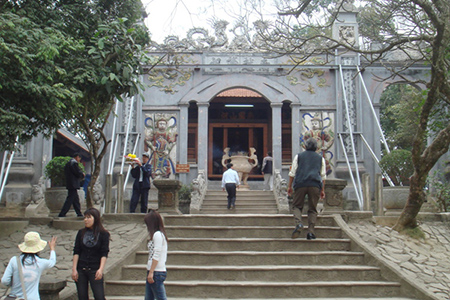This is a group of historical monuments built on Nghia Linh hill in Phong Chau area (present-day Hy Cuong commune, Lam Thao district, Phu Tho province). According to historical records…
This is a group of historical monuments built on Nghia Linh hill in Phong Chau area (present-day Hy Cuong commune, Lam Thao district, Phu Tho province). According to historical records, when establishing the capital of the Van Lang Kingdom in Phong Chau 4000 years ago, the Hung Kings chose Nghia Linh hill, 175m in height, as a site for worshipping Heaven, Earth and other Gods.
The temple has a two-storey entrance gate, similar to the three-entrance gate. The upper part of the entrance is inscribed with 4 big Chinese characters Cao son canh hanh (High Mountain and Big Road).

After passing through the gate, one must climb 225 stone steps to reach the Lower Temple area where is located Thien Quang pagoda; in front of it there is a 700-year-old tree and an imposing bell tower. After climbing down several dozen stone steps one will reach Gieng temple dedicated to two daughters of the 18th Hung King, Princess Tien Dung and Princess Ngoc Hoa. Then, after climbing 168 stone steps one will reach the Middle Temple, where Hung Kings are believed to have held discussions on state affairs with the Court. After climbing 102 more stone steps one will arrive at the Upper Temple where the Hung Kings used to have ceremonies dedicated to the Heaven God, the Earth God, the Mountain God, and the Water God. There is a horizontal board with four Chinese characters Nam Quoc Son Ha. (Mountains and Rivers of the Southern Kingdom).
In front of the temple is a stone pillar on a high base. It is called the “Swearing stone” and was where Thuc Phan, alias King An Duong Vuong, swore that he would worship the souls of the Hung Kings and preserve the Kingdom inherited from them. A few dozens of stone steps away from the’ Upper Temple is the symbolic tomb of the Hung Kings, built at the beginning of the 20th century. This group of monuments has undergone repair for several times with new structures added. There is a good number of architectural vestiges from the Ly and Tran dynasties (ancient bricks and tiles, stupas of baked earth, stone pillar, etc.) Hung King temple’s festival is held every year on the 10th day of the 3rd lunar month to commemorate the ancestors of the Vietnamese nation.

